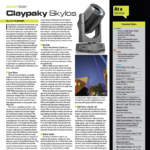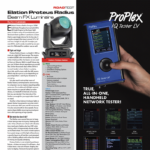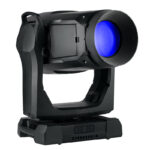Astera has been in the wireless LED luminaire market for some time now, starting when they released their first light in 2007. Today, their main offering — the AX line of lights — consists of a trio of battery-powered LED accent and wash lights aimed at the event production market — weddings, corporate events, any sort of production that needs a multitude of lights that need to be able to deploy quickly.
The Lightdrop
The smallest of the Astera AX family, the Lightdrop is a small accent light. Measuring just 3.7 inches across and 2.3 inches tall, it’s about the size and shape of two hockey pucks stacked on top of one another. A TIR lens in the center top sits over a 15-watt RGBW emitter with a native beam angle of 13°. Included diffusers change that angle to whatever is needed for the situation, including a 32° flood, as well as 120° for very wide washes. A 17° by 46° wall washing diffuser is also available separately. These diffusion options are available for all of the lights in this range. Additionally, the Lightdrop also has a hemispherical diffuser dome (available separately) for 270° illumination inside furniture or other objects, or as an accent light on its own. Two buttons on the unit provide access to power and other functions. Because there is no menu display here, addressing, mode changes and so on, are accomplished via the Astera App. Charging is done via a case with an integrated power supply and eight charging docks, or individually with an AC adapter.
The Lightdrop has a magnetic base, which holds it securely to any magnetic surface. The unit also comes with a small mounting bracket for floor mounting situations where the unit needs to be aimed some direction other than straight up or down. Users can also use the integrated adjustable foot that unscrews on the bottom to make minor tilt adjustments without attaching the full floor stand. There is also an attachment point on the side for a bracket to attach to truss, which is not included. Finally, there are three attachment points on the bottom of the fixture for attaching small eyebolts for hanging the light in the air. The Lightdrop has a runtime of up to 20 hours, with the precise timing dependent on several variables: which colors the user selects, brightness, effects, and the temperature of the surroundings. Color mixing is, as expected, from an RGBW system. All lights in the range use deep “Royal blue” LEDs for deep blue hues.
The SpotLite
At 13.4 pounds, the next largest unit in the Astera range is the SpotLite. The SpotLite follows the standard LED PAR form factor that we’ve all come to recognize, with an attached floor stand. In the head are four 15-watt CREE RGBW LED packages, for a total power of 60 watts. The SpotLite, unlike the smaller Lightdrop, has Neutrik powerCON True1 ins and thrus for not only charging, but continuous operation on a power source if desired. This unit, like the others, also includes diffusion overlays to change the beam characteristics. A note about these diffusion filters: they’re non-Gaussian (sometimes called “holographic”) diffusers and are extremely efficient, and they are not the same as a simple piece of frost gel, something the end user should be aware of in case one goes missing. The floor stands for both of the PAR lights accept a bolt for attaching standard rigging hardware such as a C-clamp for truss-mounting applications.
The SpotMax
The final light in the series is the SpotMax, which has a nearly identical form to the SpotLite. Where it differs is the output — the SpotMax has nine 15-watt RGBAW Philips LED packages for a total power of 135 watts. Like the SpotLite, it has Neutrik powerCON True1 in and thrus for charging and continuous use on a wall outlet. The additional amber emitter helps fill in the orange parts of the spectrum and makes very nice yellow and amber tones. The largest in the series is also the heaviest at 17.5 pounds.
Charging and Control
All of the lights in the range generally require between five and six hours to completely charge, depending on the ambient temperature. In extreme temperature scenarios, charging can take up to twenty hours, as there is a direct correlation between increased ambient temperature and increased charge time. Charging cases are available for both the PAR-type products and the Lightdrops, though obviously the Lightdrops have a much smaller charging station. The units all come with color calibration to ensure consistent color across the range. The calibration algorithm, in contrast to other lights on the market, detects when the user selects a “pure” color (red, green, or blue) and suppresses the mixing of other colors into the final output so that true primary colors are achievable, which is a nice touch. The dimming is quite smooth across the entire range, with no noticeable stepping — it looks as though Astera is interpolating and smoothing the incoming signal somewhat. The curve very closely matches a square law curve, and is not adjustable. Color stayed very consistent throughout the dimming range, which was a nice touch. The PWM frequency is variable from 598 to 1200 Hz, which should allow the user to adjust for any video cameras in use.
Control is done completely wirelessly; none of the products have a physical DMX input. Instead, users can control the lights either via the Astera App (Android-based devices only) which communicates via Bluetooth to an AsteraBox wireless control box, or via CRMX/WDMX wireless protocols. Addressing the two PAR-style units can be done via the menu on the back or the app, while users will always need to use the app to address the Lightdrops as they lack any external controls other than the power switch. The Astera App allows for complete control over the units, including color and brightness as well as effects, programs, and color temperature. For those who need it, there’s also a sound-activated mode built into the AsteraBox, which has an integrated microphone. The lights are also all completely silent, relying on their metal housing and fins for thermal control, a feature that should be very useful for certain special events such as weddings.
The units all have runtime settings that can be set via the application. This allows the user to input a desired runtime from one to twenty hours, and the lights will automatically throttle their brightness back in order to achieve that runtime.
As the small size and wireless nature of these units might make them attractive to small children or overly enthusiastic partygoers, Astera has included an anti-theft system on the lights that sounds an alarm if certain movement conditions are met. The alarm is moderately loud but persistent, and should be enough to deter the casual thief from attempting to walk away with the lights. Both of the PAR lights are IP65 rated even when plugged in, thanks to the watertight True1 connectors, and the Lightdrop includes a rubber cover to allow it to be used in wet conditions while plugged in as well.
At a Glance
Ready to Go, Anywhere, Any Time
The Astera AX-range of lights shows just how easy wireless LED lighting can be — just put in place and go. The free app makes controlling fast and easy without a console for smaller shows, while the wireless DMX capability allows easy use on larger events. The wireless nature allows incredibly easy and fast deployment with a minimum of labor, which saves on both labor and equipment costs as well as time, and should easily find a place on corporate events, weddings, or anywhere fast and easy deployment is a must.
PROS: Extremely easy to deploy, runtime setting very convenient
CONS: None
MSRPs:
- Lightdrop AX3: $375
- AX3-U (without LumenRadio chip): $350
- SpotLite AX7: $1,099
- SpotMax AX10: $1,799
- AsteraBox control box: $335
Manufacturer: Astera LED Technology
More Info: Greg Hodges, Astera LED Sales, 42 Elm St., Unit 4;
Kingston, MA 02364; 508.927.8403; www.asteraledsales.com



